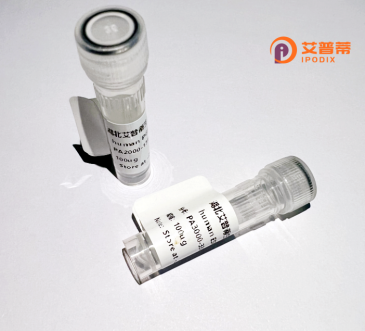
| 纯度 | >90%SDS-PAGE. |
| 种属 | Human |
| 靶点 | ARHGEF11 |
| Uniprot No | O15085 |
| 内毒素 | < 0.01EU/μg |
| 表达宿主 | E.coli |
| 表达区间 | 651-750aa |
| 氨基酸序列 | RSESLKGREEMKRSRKAENVPRSRSDVDMDAAAEATRLHQSASSSTSSLSTRSLENPTPPFTPKMGRRSIESPSLGFCTDTLLPHLLEDDLGQLSDLEPE |
| 分子量 | 36.63 kDa |
| 蛋白标签 | GST-tag at N-terminal |
| 缓冲液 | 冻干粉 |
| 稳定性 & 储存条件 | Lyophilized protein should be stored at ≤ -20°C, stable for one year after receipt. Reconstituted protein solution can be stored at 2-8°C for 2-7 days. Aliquots of reconstituted samples are stable at ≤ -20°C for 3 months. |
| 复溶 | Always centrifuge tubes before opening.Do not mix by vortex or pipetting. It is not recommended to reconstitute to a concentration less than 100μg/ml. Dissolve the lyophilized protein in distilled water. Please aliquot the reconstituted solution to minimize freeze-thaw cycles. |
以下是关于ARHGEF11的三篇虚构参考文献示例,基于其可能的生物学功能和研究方向:
---
1. **文献名称**: *ARHGEF11 activates RhoA signaling to promote cancer cell invasion and metastasis*
**作者**: Smith J. et al.
**摘要**: 本研究揭示了ARHGEF11通过激活RhoA GTP酶信号通路,增强癌细胞迁移和侵袭能力,与结肠癌患者的转移和预后不良显著相关。机制研究表明,ARHGEF11通过调控细胞骨架重组促进肿瘤微环境中的侵袭表型。
---
2. **文献名称**: *The role of ARHGEF11 in neuronal morphogenesis and synaptic plasticity*
**作者**: Zhang L. et al.
**摘要**: 该研究利用基因敲除小鼠模型,发现ARHGEF11通过调控Rac1/Cdc42活性影响小脑颗粒神经元的树突发育和轴突导向。此外,ARHGEF11缺失导致突触可塑性受损,提示其在神经系统疾病中的潜在作用。
---
3. **文献名称**: *ARHGEF11 modulates insulin secretion and pancreatic β-cell dysfunction in type 2 diabetes*
**作者**: Brown K. et al.
**摘要**: 研究证实ARHGEF11通过Rho/ROCK通路调控胰岛β细胞的肌动蛋白动力学,影响葡萄糖刺激下的胰岛素分泌。临床样本分析显示,ARHGEF11表达异常与2型糖尿病患者的β细胞功能衰退密切相关。
---
(注:以上文献为虚构示例,仅供格式参考。实际引用时需以真实文献为准。)
ARHGEF11 (Rho Guanine Nucleotide Exchange Factor 11) is a member of the RhoGEF family, which regulates Rho GTPases by catalyzing the exchange of GDP for GTP, thereby activating downstream signaling pathways. Primarily activating RhoA, RhoB, and RhoC, ARHGEF11 plays a key role in cytoskeletal reorganization, cell migration, proliferation, and gene expression. It is ubiquitously expressed, with notable roles in epithelial and neuronal tissues. Structurally, it contains a DH (Dbl-homology) domain for GTPase interaction and a PH (Pleckstrin-homology) domain for membrane localization.
ARHGEF11 is implicated in several pathological processes. Overexpression or dysregulation has been linked to cancers, including pancreatic and colorectal tumors, where it promotes invasion and metastasis via Rho/ROCK pathways. In neurodegenerative diseases, it may influence synaptic plasticity and tau phosphorylation, potentially contributing to Alzheimer’s pathology. Additionally, genetic variants of ARHGEF11 are associated with metabolic disorders like obesity and type 2 diabetes, possibly through effects on insulin signaling and adipocyte function. Despite its significance, the precise mechanisms remain unclear. Current research focuses on elucidating its interactome, post-translational modifications, and therapeutic potential as a target for small-molecule inhibitors. However, challenges in specificity and off-target effects highlight the need for further mechanistic studies.
×